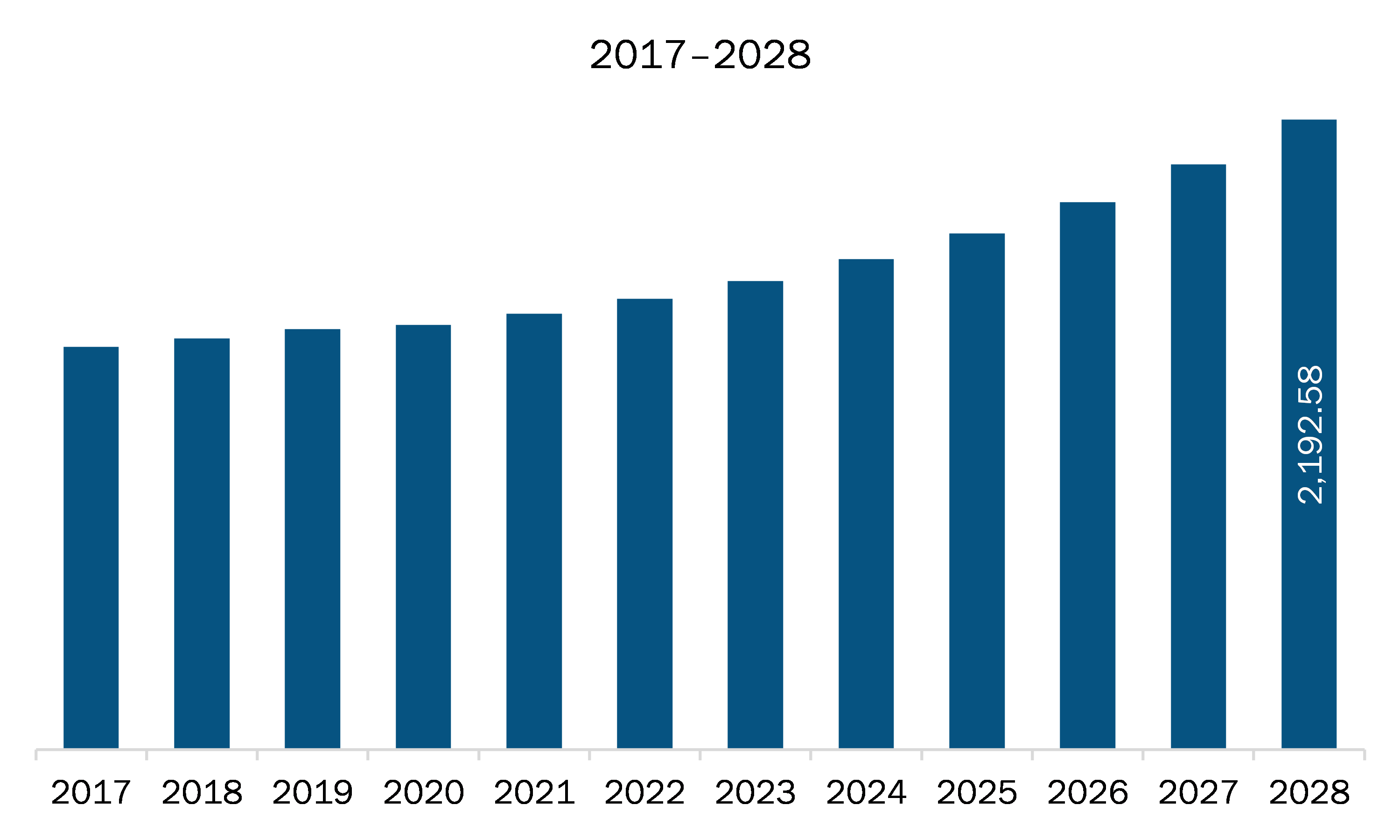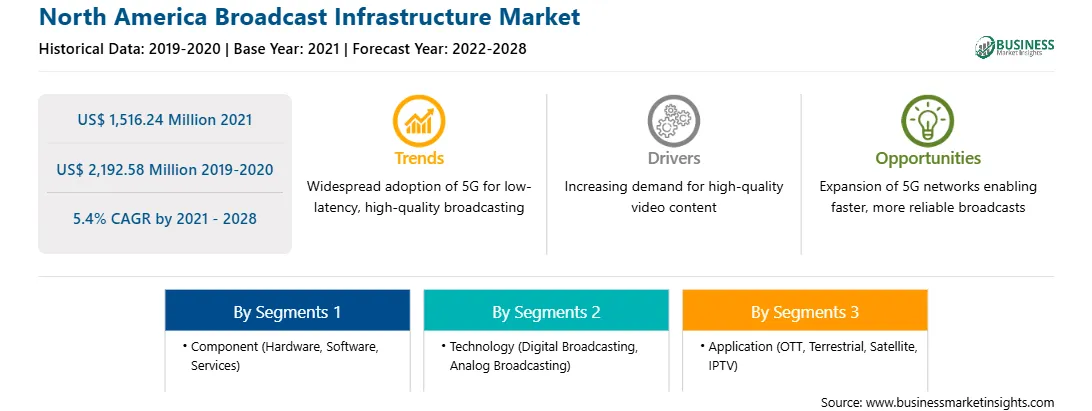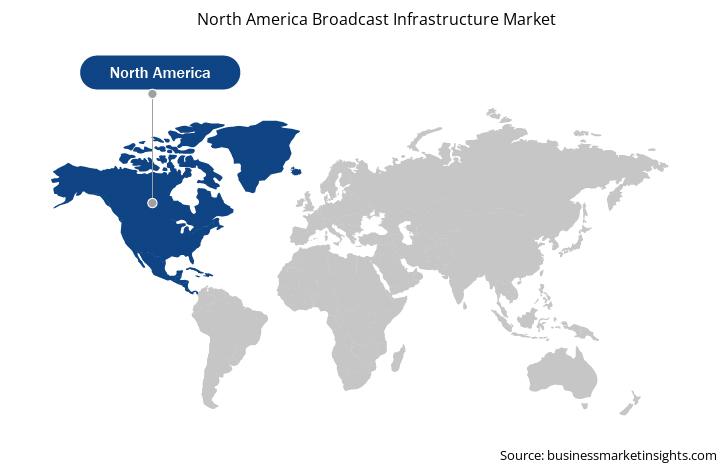North America constitutes developed economies such as the US, Canada, and Mexico. The technological advancements across North America have led to a highly competitive market. North America attracts several technological developments from economically robust countries. The companies in the region are continuously enhancing the overall business processes to meet customers' demand for high-quality products and services in the best possible way. For instance, in March 2021, Nokia completed a trial with TV Azteca, in Mexico, the second-largest media producer in the world to examine video transmission use cases using 5G standalone and edge computing. The US has shifted aggressively with the adoption of DTV utilizing the ATSC Digital Television (DTV) Standard, a powerful technology which is revolutionizing the nature of broadcast television service. This newer broadcast transmission standard offers broadcasters with several new competences to serve the public, such as HDTV and standard resolution pictures, data delivery, multicasting, robust reception modes, interactive communication, and other features. These competences deliver broadcasters the technical flexibility and multiple options to contend with other digital media such as direct broadcast satellite and cable services. In parallel with the development of the transmission technology, the US Government, with legislation by the U.S. Congress and actions by its Federal Communications Commission (FCC), has further developed public policies under which the digital television is being executed. Growing adoption of new broadcast technologies and transition from hardware to software-based infrastructure are the major factor driving the growth of the North America broadcast infrastructure market.
In case of COVID-19, North America is highly affected specially the US. North America is one of the most important regions for the adoption and growth of new technologies owing to favorable government policies to boost innovation and strengthen the infrastructure capabilities. Hence, any impact on the growth of industries is expected to affect the economic growth of the region in a negative manner. Due to the shutdown of businesses and delay in procurement activities are affecting the supply chain and significantly impacted the market. Moreover, due to the falling GDP, the market will have negative impact on the growth rate of broadcast infrastructure market. The COVID-19 crisis has drastically upended operations across the value chain, from supplier networks to the customer delivery experience. The region has presence of several electronic component manufacturers, who cater advanced and innovative components for building broadcast infrastructure. Also, the region is equipped with several companies that offer complete broadcast infrastructure for the broadcasters. The COVID-19 outbreak has severely affected these companies in production activities as well as supplying their products to their clients. However, in the coming years, the broadcast infrastructure market is expected to foresee significant growth opportunities owing to the rising demand for digital content and live streaming as well as increased subscription for various OTT platforms across the region. Thus, the overall impact of COVID-19 on the North American region is low to moderate.

Strategic insights for the North America Broadcast Infrastructure provides data-driven analysis of the industry landscape, including current trends, key players, and regional nuances. These insights offer actionable recommendations, enabling readers to differentiate themselves from competitors by identifying untapped segments or developing unique value propositions. Leveraging data analytics, these insights help industry players anticipate the market shifts, whether investors, manufacturers, or other stakeholders. A future-oriented perspective is essential, helping stakeholders anticipate market shifts and position themselves for long-term success in this dynamic region. Ultimately, effective strategic insights empower readers to make informed decisions that drive profitability and achieve their business objectives within the market.

| Report Attribute | Details |
|---|---|
| Market size in 2021 | US$ 1,516.24 Million |
| Market Size by 2028 | US$ 2,192.58 Million |
| Global CAGR (2021 - 2028) | 5.4% |
| Historical Data | 2019-2020 |
| Forecast period | 2022-2028 |
| Segments Covered |
By Component
|
| Regions and Countries Covered | North America
|
| Market leaders and key company profiles |
The geographic scope of the North America Broadcast Infrastructure refers to the specific areas in which a business operates and competes. Understanding local distinctions, such as diverse consumer preferences (e.g., demand for specific plug types or battery backup durations), varying economic conditions, and regulatory environments, is crucial for tailoring strategies to specific markets. Businesses can expand their reach by identifying underserved areas or adapting their offerings to meet local demands. A clear market focus allows for more effective resource allocation, targeted marketing campaigns, and better positioning against local competitors, ultimately driving growth in those targeted areas.

The North America broadcast infrastructure market is expected to grow from US$ 1,516.24 million in 2021 to US$ 2,192.58 million by 2028; it is estimated to grow at a CAGR of 5.4% from 2021 to 2028. Digital Terrestrial TV (DTTV) is an implementation of digital television technology to provide a greater number of channels with better picture and sound quality using aerial broadcasts. The enthusiasm toward video-on-demand (VOD) services and Digital Terrestrial Television (DTT) with advanced video and audio features among the population is growing exponentially in today’s fast-paced and technologically advanced world. With the availability of unlimited choices, other than Amazon Prime, Netflix, YouTube, and Disney plus, and on-demand channels of broadcasters, viewers are served with a vast range of options than ever before. Despite the dominance of these networks, terrestrial television continues to assert its position as a basic service to the viewers worldwide. Digital Terrestrial Television (DTT) broadcasting allows the transmission of about 10 or more digital services in a single frequency. Growing demand of smart TVs, and advancements in telecom and broadcast industry is anticipated to drive the growth of Digital Terrestrial Television (DTT). Furthermore, the VOD industry contains a number of business models, service deals, and access modes, which continue to grow significantly. Viewers rely on the VOD services that are delivered at affordable rates and help in delivering diverse viewing experience. With increasing consumption of TV sets and expenditure on terrestrial networks for quality, entertainment, and family friendly purpose, the demand for DTT has also boosted, thereby driving the North America market growth.
In terms of component, the software segment accounted for the largest share of the North America broadcast infrastructure market in 2020. In terms of technology, the digital broadcasting segment held a larger market share of the North America broadcast infrastructure market in 2020. Further, the terrestrial segment held a larger share of the North America broadcast infrastructure market based on application in 2020.
A few major primary and secondary sources referred to for preparing this report on the North America broadcast infrastructure market are company websites, annual reports, financial reports, national government documents, and statistical database, among others. Major companies listed in the report are Cisco Systems, Inc.; Dacast; EVS Broadcast Equipment; Grass Valley Canada; Kaltura; NEVION; ROSS VIDEO LTD; and Zixi.
The North America Broadcast Infrastructure Market is valued at US$ 1,516.24 Million in 2021, it is projected to reach US$ 2,192.58 Million by 2028.
As per our report North America Broadcast Infrastructure Market, the market size is valued at US$ 1,516.24 Million in 2021, projecting it to reach US$ 2,192.58 Million by 2028. This translates to a CAGR of approximately 5.4% during the forecast period.
The North America Broadcast Infrastructure Market report typically cover these key segments-
The historic period, base year, and forecast period can vary slightly depending on the specific market research report. However, for the North America Broadcast Infrastructure Market report:
The North America Broadcast Infrastructure Market is populated by several key players, each contributing to its growth and innovation. Some of the major players include:
The North America Broadcast Infrastructure Market report is valuable for diverse stakeholders, including:
Essentially, anyone involved in or considering involvement in the North America Broadcast Infrastructure Market value chain can benefit from the information contained in a comprehensive market report.